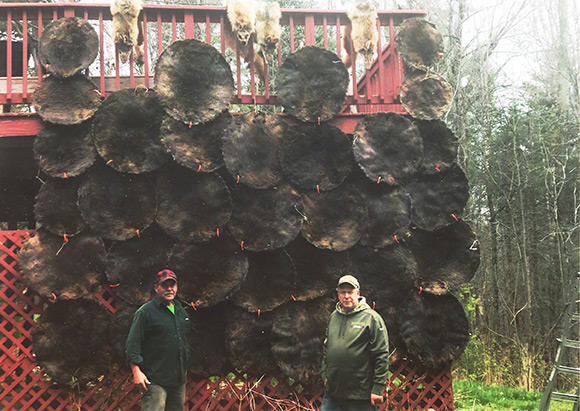 Team Fur News - Jan24
Team Fur News - Jan24
The Short, But Happy, Predator Hunting Career of Editor Taylor
By FUR-FISH-GAME Editor, John D. Taylor
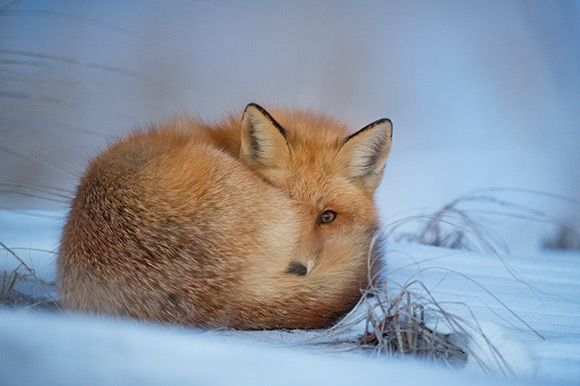
Once upon a time, red fox pelts brought $60. Photo: Ray Hennessy/Unsplash
During the mid-1970s, on the outskirts of Dallastown, Pennsylvania, along Blymire Road, up behind the high school, there was a sign advertising trout flies for sale. It read “Hand Tied Flies and Streamers for Sale, Inquire Within.” It was a white sign, 2 feet high and 4 feet long, with kinda fancy green lettering.
It was my sign.
I’d learned to tie flies in the Middle School’s fly tying club, and I gotten pretty good at spinning thread, fur, peacock hurl, tinsel and feathers around a fishing hook. I thought I could sell some flies, maybe fund my other outdoor pursuits.
Every day, hundreds of cars and maybe 30 school buses went past the sign. Some of the cars bore adults on their way to work. Others carried high school kids. But my sign seemed to go unnoticed – except for our rural delivery mailman, Mr. Sawicki.
Mr. Sawicki knocked on the front door one March Saturday afternoon and asked for me. He wanted to buy some flies.
Whoa! My first customer.
I forget what flies he bought, or how many. And I probably blew the few dollars I made at Fife’s Grocery store. It was modest bicycle ride for a high school freshman in the bustling metropolis of downtown Dallastown. I'm sure I spent it either on candy – I was teenybopper sugar junkie – or the sardines I intended to use as trapping bait, but usually ate while walking the trapline.
Time rolled on… the 1970s morphed into the early 1980s. I graduated from high school and attended college. I also had a 30-hours-a-week part-time job stocking grocery shelves at Weis Markets on the outskirts of the even more bustling metropolis of York, Pennsylvania (population 65,000). I was still tying flies, hunting, fishing and running a trapline, however.
Back then, red fox pelts were commanding $60 a throw. And with the economy in a sad state – jobs were tight, money short – everyone was gunning for foxes with traps, guns, cars, whatever. Road-killed foxes languished on the blacktop for about 15 minutes, tops.
Having common interests in the outdoors, I soon struck up a conversational friendship with one of the Weis Markets meat cutters, a guy named Wayne. He claimed to be predator calling dozens of foxes every time he went predator hunting, usually at night, which was perfectly legal even then.
At first, I bought his fox stories hook, line and sinker. But as the quantity of foxes increased with each telling, I became suspicious. Did he really shoot that many foxes? Or even see that many? Or was he full of hooey?
Now, I’d been trapping for several years at that point. I could catch muskrats, possums and coons. But between the enormous amount of competition for fox pelts and the lack of access to prime fox territory, like in the southern end of the county, I’d caught a grand total of one fox in a dirthole. Ever. Foxes, dug out my traps, hoisted a leg on them, or simply ignored them, despite doing (almost) everything Paul Failor recommended in his book, my trapping bible, “Pennsylvania Trapping and Predator Control Methods.”
So, I got curious. Maybe I could get some foxes predator calling. Wanting to learn more about it, I talked at Wayne, then bought a predator call, a hand-held wooden dying rabbit squealer. I was determined to set the fox calling world on fire and stack fox pelts knee deep.
It was winter then, so I also made a white, winter camo coverall from some old fabric my mother had left over from sewing projects, sheeting and stretchy polyester stuff. It was basically a big, knee-length parka with a hood and tie strings at wrists to seal me up.
Applying some duck hunting knowledge – a bright human face staring up from a blind will spook ducks – I found some white theatrical makeup, the stuff clowns used, to complete my camouflage. Yes, I was essentially a predator hunting winter clown. And that's just as scary as it sounds.
I also bought a Savage .222, the ultimate fox gun, according to Wayne, with a 3 - 9X scope on it. I thought its reach would really juice up my fox hunting.
During winter break from college in January, I decided to try fox calling.
I drove Dad’s 1975 Bronco to a place I knew had some foxes, public land in the middle of some dairy and crop farmland. (That parcel that eventually became county parks property, annexed as the darling spot for rich lawyers to ride their horses. They hated hunting and succeeded in banning hunting there, without special permits and all kinds of dumb regulations.)
I got decked out in my white camo coverall, smeared the white makeup on my face, slipped quietly to an overlook, hid in puckerbrush, and started calling.
My poor bunny was being horribly tortured by an evil predator, the squeals screaming across a small valley lined with brush adjacent to a large creek bottom that fed Lake Redman.
It wasn’t long before a red fox popped out of the brush in the bottom of the valley and stopped, staring in my direction, maybe 150 yards out. I felt confident I could collect this fox because I’d sighted in my .222 at the range a few days earlier.
The scope settled, the crosshairs aligned, I squeezed the trigger.
At the shot, the fox bolted and tore off through the brush, heading for the Maryland state line. I’d called up a fox but blew the shot. Later, I’d learn that whoever mounted the .222’s scope hadn’t used Loc-Tite on the bases, which meant you could shoot the light recoiling rifle and be on target one day, but hit a foot to the left the next, despite babying the rifle and scope. (I eventually sold that rifle to fund my trip to work for a summer for a big game outfitter in the Great Bear-Bob Marshall Wilderness in Montana after graduating from college.)
Dejected at another failure to collect fox pelts and fund my education or my fun, I trudged up out of the valley and started walking back towards the Bronco at the top of the hill.
That’s when I spied a U.S. Postal Service Jeep parked along the gravel road, motor running.
I recognized the driver. It was Mr. Sawicki. I hadn’t seen him in a few years, and I was curious if his flies caught fish.
Still festooned in the white camo coverall, my face painted clown white, I approached the white USPS Jeep unnoticed from behind and to the right of the truck’s window. Mr. Sawicki was drinking a cup of coffee from a thermos.
I went right up to the window, knocked on it.
“Hiya, Mr. Sawicki,” I said.
Mr. Sawicki jumped about a foot out of his seat and the thermos fell to the truck’s floor.
I don’t think he recognized me, knew where the voice came from, or what the big white thing beside his Jeep was – the abominable snow man, Sasquatch? I probably took years off the poor man’s life, scaring him like that.
He eventually rolled down the window, and we talked a little bit.
I would eventually tie flies by the dozens to sell to Chet Patterson’s, a local sporting goods store, which cured me of ever wanting to be a professional fly tier. If I never tie another No. 18 Royal Coachman after doing three dozen at a clip, I’ll die a happy editor.
I swore off predator hunting for a while, too, until we moved West, and some coyotes answered my hand calls. But I kinda miss Mr. Sawicki and seeing his Jeep when I go predator hunting these days.
Midwest Deer Harvests Tallied
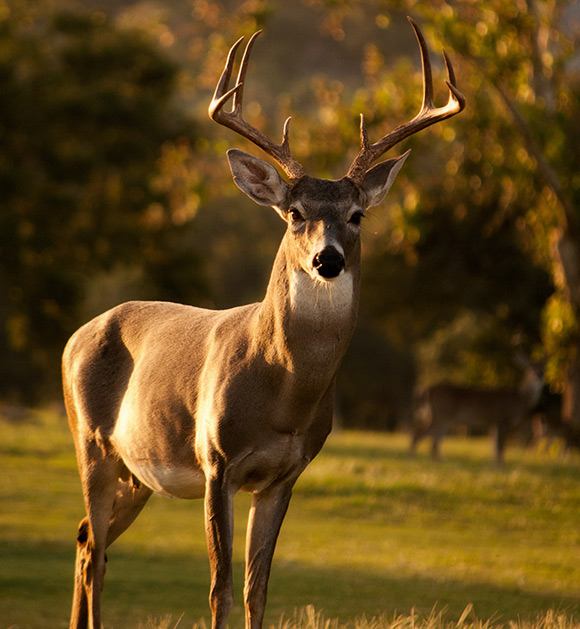
Deer hunters across most of the Midwest recorded average deer harvests. Photo: Laura College/Unsplash
Several state wildlife agencies have compiled the preliminary numbers from deer seasons across the Midwest, and it appears most states did fairly well. Here’s an overview. For a more complete picture, visit each state’s wildlife agency website.
Ohio – Ohio’s week-long gun season concluded with hunters taking 70,118 deer, according to the Ohio Department of Natural Resources (ODNR) Division of Wildlife. Hunters checked 25,044 antlered deer (36% of the harvest) and 45,074 antlerless deer (64%). The top counties included: Coshocton (2,441), Tuscarawas (2,260), Ashtabula (2,189), Muskingum (2,076) and Knox (1,880). Last year, hunters took 71,931 deer during the gun week. The three-year average for deer harvest during the seven-day gun season is 71,322. An additional weekend of deer gun hunting took place Dec. 16 -17, and results from this were not available. Straight-walled cartridge rifles were used to harvest 60% of the deer checked, shotguns accounted for 34%, 4% were taken with a muzzleloader, 1% with archery equipment, and 1% with a handgun. Nonresidents purchased 37,543 hunting licenses. Altogether, archery and firearms hunters took 167,732 deer. For archery hunters, November 11 proved the best day, 4,621 deer checked. Other top archery days include Nov. 4, with 4,393 deer; Nov. 5, 3,727 deer; and Nov. 12, 3,025 deer. Hunters generated some $1.9 billion in economic spending in Ohio during the 2022 hunting season, according to a Wildlife Management Institute report. About 5% of Ohio’s adults, 500,000 individuals, hunt, with 91% of those hunters chasing deer.
Illinois – Hunters in Illinois took a preliminary total of 76,232 deer during the seven-day Illinois firearm deer season that concluded Dec. 3. By comparison, hunters harvested 76,854 deer during the 2022 firearm season. Preliminary harvest figures for the second segment of the firearm season, Nov. 30 - Dec. 3, was 22,884, compared with 24,500 deer in 2022. The preliminary harvest for the first segment of this year’s firearm season Nov. 17-19 was 53,348 deer.
West Virginia – Hunters harvested 45,155 bucks during the traditional buck firearms season, Nov. 20 – Dec. 3, according to preliminary figures from the West Virginia Division of Natural Resources’ (WVDNR) electronic game checking system. The 2023 harvest was 7.5 percent below the 2022 harvest, which totaled 48,810 bucks. DNR expected this reduction, due to less mast in the forest and bad weather for the opening days of the season. All areas of the state registered an average decrease of 11 percent, except for the southeastern region which had an increase of 19 percent from the 2022 harvest. Top counties included Greenbrier (1,892), Randolph (1,604), Preston (1,413), Pendleton (1,413) and Monroe (1,396). Deer hunting continued into December with archery, crossbow and muzzleloader season, no figures were available for these hunts.
Missouri – The Missouri Department of Conservation (MDC) reports that 90,334 deer were harvested during firearms opening weekend, Nov. 11 and 12, with the top counties Franklin, (2,114); Texas (1,825) and Howell (1,726). Of those 90,334 deer, 53,159 were antlered bucks, 7,163 were button bucks, and 30,012 were does. MDC sys the opening weekend totals were similar to the previous five-year average. Last year, hunters checked 93,355 deer during opening weekend of the November portion of firearms deer season. Deer hunting continued throughout November, when an estimated total of 193,669 deer were harvested during the firearms season. Top counties remained Franklin, Texas and Howell. This year’s harvest total was 3% lower than last year, but 2% higher than the previous five-year average. An additional 18,904 deer harvested during late antlerless portion of the season, Dec. 2-10, with top counties being Callaway, Pike and Lincoln
Wisconsin - The Wisconsin Department of Natural Resources (DNR) says the number of deer licenses sold declined compared to 2022. Gun, bow, crossbow, sports and conservation patron licenses totaled 774,369. Of that total, 421,525 were for gun privileges only. The year-to-date sales for all deer licenses are down 0.61% from the same time last year. Most licenses were sold online. Declining license sales resulted in fewer deer being harvested. Hunters registered 92,050 deer statewide on opening weekend of the 2023 gun hunt, compared to 103,623 registered for the same period in 2022. This is a 16% decrease from 2022 and 10% below the 5-year average. A total of 51,870 bucks were registered on opening weekend, compared to 56,638 in 2022, a 13% decrease.
Nebraska – The firearm deer harvest in Nebraska was down 18% statewide, compared to 2022 and 29% from the 2018-2022 average, according to Nebraska’s Game and Parks Commission (NGPC). NGPC anticipated this. Several factors played a role: severe drought in recent years, led to an increase in epizootic hemorrhagic disease; reduced number of deer permits predicated on lower deer numbers in 2022; also, severe winter weather in 2022 that reduced food sources and increased deer stress, particularly in northern Nebraska. By district, the 2023 harvest was down 26% from 2022 and 35% from the five-year average in the northwest; 21% down from 2022 and down 37% from the five-year average in the southwest; down 16% from 2022 and down 30% from the five-year average in the northeast; and down 11% from 2022 and down 9% from the five-year average in the southeast. Some Nebraska deer seasons continued into December and the River Antlerless late season is taking place Jan. 1-31.
North Carolina Sets Record Spring Turkey Harvest
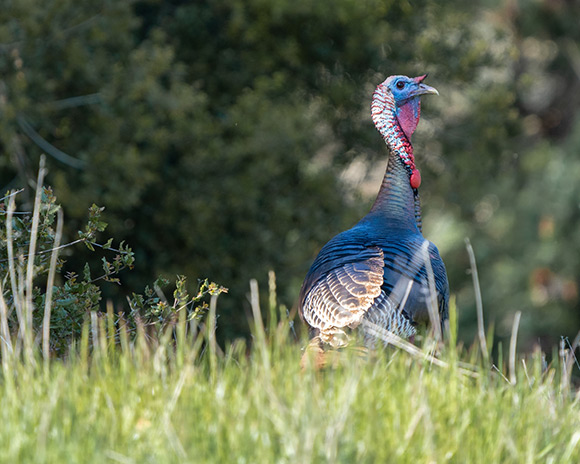
North Carolina’s 2023 spring turkey harvest set a new record of more than 24,000 gobblers.
Photo: y-s-E_ye/UnSplash
North Carolina’s five-week spring wild turkey season set a harvest record of 24,089 birds, according to state Wildlife Resources Commission. The 2023 tally surpassed 2020’s record bag of 23,341 birds. Turkey harvests in North Carolina are somewhat different than in other southeastern states. In those states, harvests peaked several years ago and are declining somewhat. The state’s record harvests are being driven by increases in the southeastern part of the state, NCWRC says, likely spurred on by improved turkey reproduction in 2021. “This year’s total harvest statewide was 9.5% higher than the average of the previous three years,” Upland Game Bird Biologist Hannah Plumpton said. “Also, all three ecoregions had noticeable increases in harvest in relation to the 2022 season, particularly in the coastal region.” To put the harvest in perspective, biologists typically compare it to the average annual harvest over the previous three years. Harvest during the week-long youth season increased by 11%, with 2,478 birds reported. Mountain turkey harvests increased by 5%, piedmont 6%, coast 14%. Hunters took 15% more adult gobblers, 20% fewer jakes. The top five counties were Duplin (829), Pender (689), Bladen (652), Sampson (585) and Brunswick (571). For more information, visit www.ncwildlife.org.
Wisconsin Bear Harvest Down
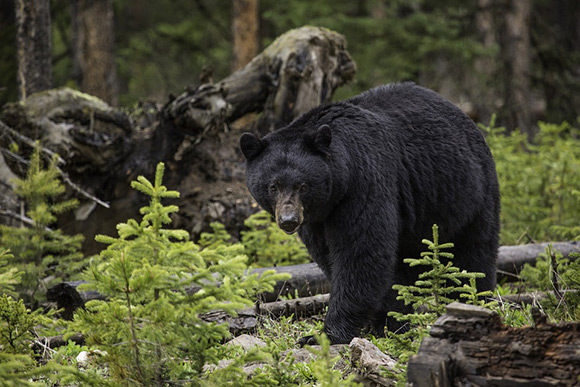
Wisconsin’s bear harvest fell 23% last fall.Photo: Wisconsin Department of Natural Resources
Wisconsin’s 2023 bear harvest was well below the recent annual average of 4,000 bears, the lowest yearly bear harvest since 2008, according to the Wisconsin Department of Natural Resources (WDNR). Bear hunters tagged 2,922 bears this year, compared to 4,009 bears taken in 2022. Overall hunter success dropped to 23%, down from the 5-year average of 32% – although success rates varied from 60% in Zone A to about 5% in Zones E and F. The decline was statewide, with the harvest falling short of management objectives in all zones "This fall saw a remarkably high acorn crop across much of the state, and this abundance of natural food typically results in reduced hunter success rates as hunters' baits are less effective," said Randy Johnson, WDNR large carnivore specialist. "Almost all of the anecdotal reports I heard from bear hunters this fall mentioned the incredible abundance of acorns and other natural foods in the woods. It is difficult to predict when these bumper acorn crops will occur, but when they do, the impact on bear hunting is unmistakable." The bear season took place from Sept. 6 to Oct. 10. Nearly 138,000 people applied for a bear license, a record number of applicants, 12,760 hunters received bear tags via a license lottery. WDNR says interest in Wisconsin bear hunting is growing and the state has a thriving and expanding bear population, estimated at approximately 25,000 individuals. Visit dnr.wisconsin.gov for more information.
Learn to Ice-Fish
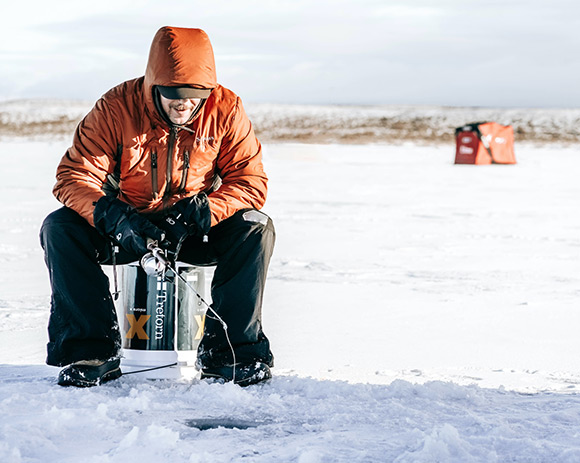
Nebraska Game and Parks Commission is helping anglers learn how to ice fish.
Photo: Glenna Haug/Unsplash
Anglers can learn the basics of ice-fishing or pick up a few new tips from experienced anglers at the Nebraska Game and Parks Commission’s (NGPC) Youth Fishing Program’s “Discover Ice-Fishing” clinics in January. NGPC will host three on-ice events and one classroom event. From 10 a.m.-noon Jan. 13, the Nebraska Fish and Game Association will host a classroom clinic at Northeast Community College in Norfolk. This will feature presentations by some of Nebraska’s top ice fishermen. Seating is limited, so registration is requested via the calendar event entry at Calendar.OutdoorNebraska.gov. From 1-4 p.m. Jan. 13, anglers can head out to Skyview Lake (the west park access of N. 25th Street), in Norfolk, to “Discover Ice-Fishing” with volunteer instructors helping anglers learn skills on the ice. The other on-ice events will be from 1-4 p.m. Jan. 20 at Lincoln’s Holmes Lake (located about mid-lake along the north shoreline road), and 1-4 p.m. Jan. 27 at Omaha’s Flanagan Lake, 168th and Fort streets. Limited loaner equipment will be available on a first-come, first-served basis. Bait and instruction will be provided. Participants are encouraged to bring their own equipment. All fishing regulations and permit requirements apply. A lack of safe ice will force the cancellation of the on-ice events.
WVDNR seeks art Wildlife Calendar
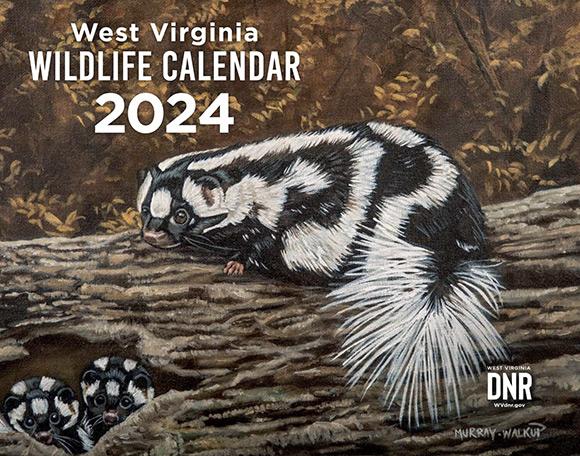
Artists who want a chance to have their wildlife paintings featured in the 40th anniversary edition of the West Virginia wildlife calendar have until Feb. 14, 2024, to send their artwork to the West Virginia Division of Natural Resources (WVDNR). Each year, WVDNR selects 12 paintings for its award-winning calendar based on overall composition, quality and anatomical and contextual accuracy. All artists, especially those from West Virginia, are encouraged to submit their work. A $200 prize is awarded for each chosen painting. The artist whose artwork is selected for the cover receives an additional $500. Art must be original color paintings on canvas or another flat surface and must depict native game, fish or other wildlife found in West Virginia, such as snakes, frogs, turtles, salamanders, bats, songbirds, small mammals and nongame fish. Photographs and paintings with wildlife not found in West Virginia will not be considered. Paintings depicting hunting or fishing activities may be submitted. The calendar is horizontal, and art should be at least 14.5 inches wide by 11.5 inches high. Artists who want to send art should mail a high-resolution copy to: WV Division of Natural Resources, Wildlife Calendar Art, P.O. Box 67, Elkins, WV, 26241. Questions? Call (304) 637-0245 or visit WVdnr.gov/wildlife-calendar.
Cougar Killed in Buffalo County, Wisconsin
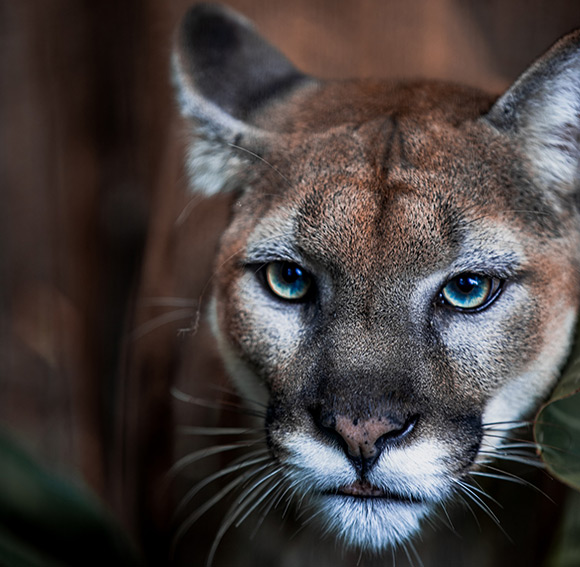
A protected cougar was killed in Wisconsin last November, but no charges were filed
because the archery hunter felt his safety was being threatened. Photo: Wilson Chen/Unsplash
The Wisconsin Department of Natural Resources (WDNR) has confirmed the fatal shooting of a cougar in Buffalo County on Saturday, Nov. 11, 2023. Cougars are a protected species in Wisconsin, so WDNR wardens conducted a thorough investigation of the shooting and provided the information to the Buffalo County District Attorney. After careful review and consideration, no charges will be filed. The incident involved an archery deer hunter who encountered the cougar while hunting and felt their safety was at risk. The hunter shot the cougar and self-reported it shortly afterward to WDNR. WDNR collected the cougar carcass as part of the investigation. Cougars are a native to Wisconsin but were extirpated from the state in the early 1900s. WDNR hasn’t confirmed a breeding cougar population in the state, but cougar sightings have increased, with about 15 to 20 reports verified by WDNR annually during the last 20 years. Most evidence says these cougars are dispersing individuals from established populations in the West. The public is encouraged to report cougar sightings via the DNR’s Wildlife Observation Tool. Visit https://apps.dnr.wi.gov/wildlifeobservation/.
Upcoming Events
• New York Fur Auction - The Fulton-Montgomery Fur Harvesters and the Foothills Trappers Association will host two fur 2024 auctions in Herkimer, New York, at the Herkimer VFW post. The auctions will be held February 4 and April 13. Doors open at 6 a.m., fur sales begin at 8 a.m. For more information, contact Paul Johnson, president of Fulton-Montgomery Trappers at (315) 429-2969 or Neil Sowle, treasurer of Foothills Trappers at (518) 883-5467.
• Michigan Trappers’ Workshop - The 19th annual Michigan Upper Peninsula Trappers Workshop will be held on Saturday, Feb. 3, 2024, in Hermansville, Michigan. The event is focused on kids and beginning trappers. Free trapping supplies to take home will be available for all kids attending, and the event includes trapping demos, a fur buyer and a supply vendor. Contact Mike Lewis at (906) 774-3592 for more information.
• WV Trappers Fur Auction - The West Virginia Trappers Association will hold their annual Fur Auction March 1-3, 2024, at the Gilmer County Recreation Center, 1365 Sycamore Run Road, Glenville, West Virginia. Vendors will be present throughout the weekend. Consignment for finished fur, etc., begins at 9 a.m., Friday, March 1, and continues through Saturday, March 2. The fur auction will be held Sunday, March 3, at 1 p.m. A board of directors meeting will held be Friday, March 1, at 7p.m. Admission is free, and all are welcome to attend. For more information, contact Jeremiah Whitlatch, at (304) 916-3329 visit www.wvtrappers.com
• Texas Trappers & Fur Hunters Spring Rendezvous - The Texas Trappers & Fur Hunters Association will hold their Spring Rendezvous, April 26-27, 2024, in the Mashburn Event Center, located at 1100 7th Street NW, in Childress, Texas. The Rendezvous features demonstrations, a live auction and other happenings. For more information, contact Matt Carter at (830) 505-0033, or visit www.ttfha.com.
• Central Maine Spring Fur Auction - The Central Maine Chapter of the Maine Trappers’ Association is holding its annual Spring Fur Auction on April 21, at the Palmyra Community Center, located at 768 Main St., Palmyra, Maine. Doors open at 7 a.m. For more info contact Ted Perkins at (207) 570-6243 or check mainetrappers.com for updates.
• Idaho Trappers Assn. Fur Sales, Banquet - The Idaho Trappers Association will hold a fur sale March 8 -10 at the Elmore County Fairgrounds, in Glenns Ferry, Idaho. The event features trapping demos, the live auction, trap and lure vendors and other items. On Saturday, April 6, ITA, Furbearers Unlimted and NTF will host an annual banquet at the Twin Falls County Fairgrounds, 215 Fair Ave, in Filer Idaho. For more information, contact Mike Murdock at (208) 716-0377, email: mikemurdock95@gmail.com, Rusty Kramer at (208) 870-3217, or visit https://www.idahotrappersassociation.com/
What’s Coming in February
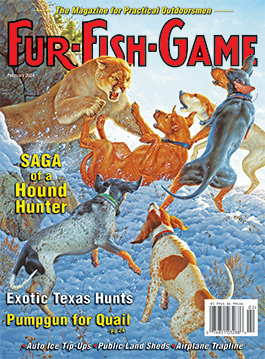
Saga of a Hound Hunter - Trevor Hubbs writes that if he is at all a skilled woodsman, it’s because of his time behind his dogs – hounds – and tells the tale of a killer cougar and hound revenge set in Indiana.
Finding Sheds On Public Land - Will Bowen tells how finding whitetail sheds on public land is not all luck. He has a system for doing it effectively.
Auto Tip-Ups for Icing Trout - Phil Goes looks at using auto tip-ups to catch trout through the ice.
Airplane Trapline - Tom Miranda shares his adventures using an airplane to run a long South Dakota trapline during the 1980s.
Exotic Game Hunting In Texas - Luke Clayton shares the history of Texas exotics and how to get involved in hunting axis deer, blackbuck antelope, aoudad sheep and other exotic game in his state.
Other stories include:
• Pumpgun Panacea, by Garhart Stephenson, looks at how pump shotguns can help desert quail hunters.
• Cold-Rolling Muskrats author Brett Bonecutter shares his tale about trapping muskrats under ice.
• An Indispensable Trapline Tool writer William Canfield tells how he turned a broken hoe into a trapline tool that he finds incredibly useful.
• The Opportunistic Coyote Hunter Are you prepared to take coyotes to help wildlife populations at any time? Heath Curtis tells how to get prepared.
• Modern Wolf Traps is a review of wolf traps. David O’Farrell offers help choosing those that perform best.
• BMP Furbearer Exams writer David Zeug looks at how the Association of Fish and Wildlife Agencies is helping trappers protect their rights by examining the traps’ impact on animals caught to provide science-based information to fight anti-trapping forces.
• Fat Balls author Dan Perkins shares a funny tale about the trials and tribulations of fat balls, the residue of pelt fleshing, and how these balls get all over everything.
End of the Line Photo of the Month
Charles Verrill and Len Sherwood - Gray, Maine
SUBSCRIBE TO FUR-FISH-GAME Magazine

